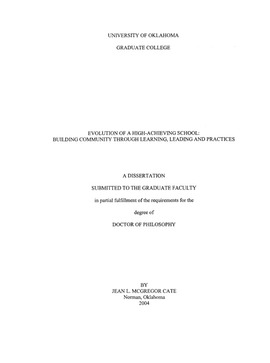| dc.contributor.advisor | Vaughn, Courtney Ann, | en_US |
| dc.contributor.advisor | O'Hair, Mary John, | en_US |
| dc.contributor.author | Cate, Jean L. Mcgregor. | en_US |
| dc.date.accessioned | 2013-08-16T12:19:24Z | |
| dc.date.available | 2013-08-16T12:19:24Z | |
| dc.date.issued | 2004 | en_US |
| dc.identifier.uri | https://hdl.handle.net/11244/727 | |
| dc.description.abstract | The achievement gap of ethnic and poor students has haunted educators, and some schools have narrowed the gap through building learning communities. The purpose of the study was to understand how changes occurred in a traditional school as it transformed into a high-achieving democratic learning community. Newmann and Wehlage (1995) indicated that improved student learning occurred when schools organized as learning communities. Leaders of learning communities who distributed leadership across the community (Spillane, Halverson & Diamond, 1999) and created communities of practice facilitated the learning of both explicit and tacit knowledge across the community (Wenger, 1998) and created conditions that supported new strategies for addressing diverse students' learning needs. Democratic schools were communities in which students experienced authentic learning and democratic practices (Apple & Bean, 1995, O'Hair, McLaughlin & Reitzug, 2000). | en_US |
| dc.description.abstract | To explain how the community changed and evolved, four sets of data were gathered over seventeen years, including documents, in-depth interviews, field notes and a learning-community survey. The analysis of data produced themes and created a historical, interpretive case study (Merriam, 1998) of the processes, interactions and relationships that occurred as the community evolved. When the school joined a university-school network, inquiry erupted and teacher learning began. Through the network, teachers examined the IDEALS of a democratic learning community (O'Hair, et al., 2000). Teachers' learning was shared and leadership skills were built. Communities of practice (Wenger, 1998) were created through book studies, site goals, grade level and vertical teams led by teacher leaders (Lambert, 1998). As teachers inquired their own practice, their knowledge of how to address student needs was enhanced. Communities of practice coordinated and moved knowledge across the community. Through learning, distributed leadership (Spillane, Halverson & Diamond, 1999) and communities of practice, student achievement increased. The school exceeded the achievement scores of much less diverse and lower poverty level schools. Red Bud became an example of a high-achieving school (Haycock, 2001) that closed the gap and provided a model for others. This study told their story. | en_US |
| dc.format.extent | xiii, 185 leaves : | en_US |
| dc.subject | Educational change Case studies. | en_US |
| dc.subject | Education, Elementary. | en_US |
| dc.subject | Education, Administration. | en_US |
| dc.subject | Educational change Oklahoma Case studies. | en_US |
| dc.title | Evolution of a high-achieving school: Building community through learning, leading and practices. | en_US |
| dc.type | Thesis | en_US |
| dc.thesis.degree | Ph.D. | en_US |
| dc.thesis.degreeDiscipline | Department of Educational Leadership and Policy Studies | en_US |
| dc.note | Major Professors: Mary John O'Hair; Courtney Ann Vaughn. | en_US |
| dc.note | Source: Dissertation Abstracts International, Volume: 65-02, Section: A, page: 0357. | en_US |
| ou.identifier | (UMI)AAI3122311 | en_US |
| ou.group | Jeannine Rainbolt College of Education::Department of Educational Leadership and Policy Studies | |
